In Conversation with Steve Kenyon: Climate Change and Regenerative Agriculture
Steve Kenyon is a regenerative rancher, farmer, and advocate for “growing soil”. He runs Greener Pastures Ranching, a diverse family farm, with his wife, Amber, in Busby, Alberta. For part of his childhood, Steve grew up on a grain and cattle farm in Saskatchewan, just south of Lloydminster. He studied agriculture in college. After attending his first Allan Savory conference, focusing on holistic land management, he was inspired to apply sustainable principles to the way he farmed, and began practicing rotational grazing management. Early on, Steve also studied with the Ranching for Profit program, which helped him create a farm plan for environmental and economic sustainability.
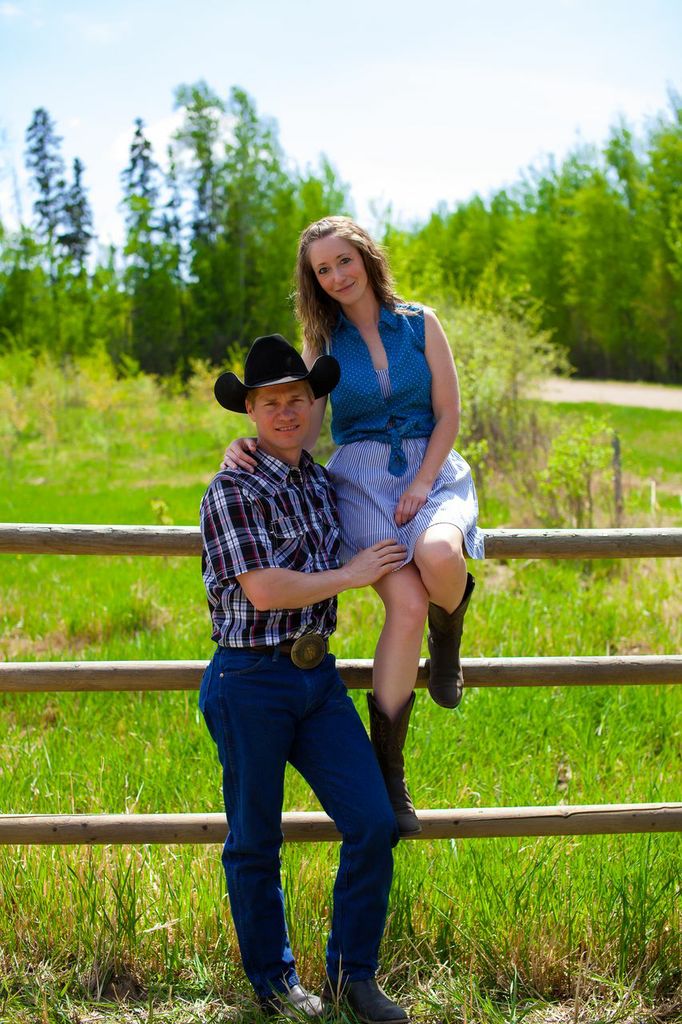
Steve and Amber focus mainly on custom grazing cattle on leased land using intensive rotational grazing management. In the summer, he manages 3000 acres for 1200 yearlings. In the winter, a reduced number of cattle feed on cut forage laid out in swaths, or bale grazing. They are also raising pasture-raised pork.
Recently, Rural Routes to Climate Solutions (RR2CS) connected with Steve to learn more about his story, farming philosophy, and reflections on how regenerative agriculture can be a tool to limit climate change.
RR2CS: What do you think is missing from today’s conversations around agriculture and climate? What should we absolutely be talking about?
Steve: Building soil. It’s not about raising crops, or livestock. Modern agriculture grows plants from the soil. Farmers believe the plants grow from the soil. With regenerative agriculture, we grow the soil from the plants. Now, there’s a huge difference there. We use the plants to pull carbon out of the air, through the dead plant material, through the decomposing roots, and through the root exudate (the sugars that are being pushed out through the root tips).
Modern agriculture looks at it the wrong way. Farmers are growing plants, so they have to add inputs and fertilizer. Then the plants use up that fertilizer to grow the crop, exporting nutrients off the land. Farmers then have to replace the nutrients to do it again. It’s a constant exporting of the nutrients, degrading the land, and then struggling to fix it. Regenerative agriculture takes a different approach. Dirt is just silt, sand, and clay. But when we start gluing those particles together with exudate, so the sugars that are pushed out the root tips – we’re building soil. We’ve got organic matter. There’s water holding capacity. That’s where the nutrients are. That’s where the bacteria and fungi can create an environment where it’s suitable for them to live and do their job. The biggest thing we’re lacking in agriculture is the understanding that we need to grow soil. We’re not growing plants, we’re not growing animals. We need to grow soil. As a regenerative farmer, I use the plants to grow the soil. I use the animals to manage the plants that grow the soil.
RR2CS: You’ve written before that it’s time to “throw away” the modern agriculture cookbook. Can you expand more on this idea and why it’s important?
Steve: Many farmers want recipes. Species to plant, an order of rotation. When I give a presentation, I know what slide everyone is going to take a picture of or write down because it’s a recipe. But the problem with nature is that nature doesn’t work with recipes. It changes. It’s variable. One year you do it this way, the next year you do it another way. I think that’s what stimulates nature more than anything – the change. The adjustments, the tweaking. My recipe for farming is that there is no recipe. Many farmers are just following the recipe – and that’s part of the problem. In truth, there’s a lot of farmers out there who are abusing their land. We need to break free of recipes and actually observe the land. There a lot of issues in agriculture that we need to get past, but most of it is pushed by Big Ag because there’s a lot of money in it.
RR2CS: What are some of those main issues?
Steve: Let’s get into the whole picture. Big Ag pushes fertility. I just got back from speaking at a conference that was called Nutrient Management. As I expected, most of the speakers were talking about fertilizer rates, how to handle fertilizers, how to transport it, and how to spread manure properly so you don’t contaminate the environment. It was all about adding fertility to the land. I stood up and said, ‘I’m the odd man out again, I’m going to talk about nutrients from a completely different angle because I believe that agriculture is not about adding fertility, it should be about building biology.’ If you build soil biology, you get free fertility. If we can get the microbiology, bacteria, fungi, and all of the important critters in the soil functioning correctly, we don’t need fertility. Nowhere in nature do you find a nitrogen deficient plant. It doesn’t happen. Nature finds a way. Only in agriculture do we see deficiencies. We break the system and wonder why we have to pay big dollars to get things functioning.
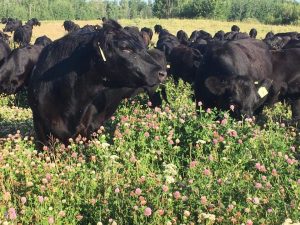
RR2CS: As a farmer, have you seen changes in the weather over the years?
Steve: I would say yes. Just look at Australia right now. It’s either a drought, flood, or fire. That’s some pretty extreme weather. Look at California. These extreme weather events are happening all over the world. In Busby, Alberta, we have some droughts, yes. According to municipal stats, we’ve had seven years of drought in the last eleven years. But to me, it’s not as severe on our farm – and that’s because we’re managing for it. We can get through three months without rain and it doesn’t really affect us. Whereas, other farms can go for three weeks without rain and their plants stop growing.
Heavy storms. We used to get some pretty heavy storms back in the day when I was a kid. I remember heavy snow and rain storms, but I think the severity and how frequently they come might be increasing. We need to prepare for that. And, to me, it’s so obvious. This is about a broken water cycle. We, as farmers, there’s no one else on the planet that has more ability to manage or mismanage the water cycle. We could solve it, on a global scale. If we could learn to manage the water cycle, many of the problems we’re seeing would go away. Not entirely, of course, but it wouldn’t be nearly as severe. The droughts, storms, and floods wouldn’t be as severe.
RR2CS: Let’s talk more about water. In a few of your articles, you write that “water is the most important nutrient.” Can you expand more on this idea?
Steve: I get farmers who argue with me all the time that water is not a nutrient. I’ll tell them, you’re wrong. It’s hydrogen and oxygen. It’s no different than carbon, or nitrogen, or phosphorus. They’re elements; nutrients that the plant needs. In comparison, if a crop needs 50 lbs of nitrogen to produce X number tonnes of forage, it needs about 10,000 lbs of water. Water is the most important nutrient by far – and it’s free, you just have to get it.
I want to give you a quick description of a healthy water cycle. In a healthy system, moisture evaporates from lakes, rivers and streams, then forms clouds, precipitates down, soaks into the soil, and infiltrates through the ground to fill the creeks and dugouts from underground. But what modern agriculture has done, we’ve caused a reverse water cycle from tillage, exposed soil, and overgrazing. Now the moisture evaporates out of the soil instead of staying in the soil and soaking down. It’s drying out and evaporating because we don’t have residue or cover on top. It evaporates, forms clouds, rains down, and runs off the land because the raindrops damage the land and it doesn’t penetrate through, taking with it erosion, nutrients and organic matter and washing that into our lakes, rivers, and creeks. We’re filling our water bodies from run off instead of underground through infiltration. That’s an unhealthy water cycle. That’s what most of agriculture does now. That’s why we see extreme floods, that’s why there’s flash storms and extreme droughts – it’s all because of an unhealthy water cycle.
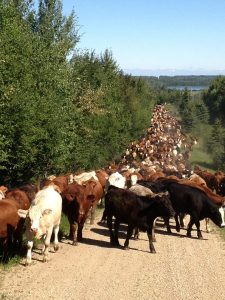
RR2CS: So how can farmers remedy, or improve the water cycle?
Steve: Build soil. We need to leave ground cover on top to stop the soil from capping. When the rain drops come down and damage the soil, it causes the soil to cap. In order to prevent capping, we need to leave residue (dead, or live plant matter) on the top. Tillage isn’t going to do that, and overgrazing doesn’t leave residue on the top. The more residue, the better. We can also build soil underground through the root systems; through dead, decaying roots and also through the root exudates – sugars that are excreted out through root tips – which is essentially carbon being pumped into the soil. Organic matter will increase the soil’s water holding capacity.
I recommend Googling something called a rainfall simulator. It’s a very powerful visual tool that allows you to see the difference between run-off and infiltration.
RR2CS: Do you often have to remedy the land that you lease for grazing?
Steve: Yes. All of it. Every bit of it I’ve had to fix. I took one plot over last year that was pretty good. I was surprised. They’d understocked it, so there was lots of residue out there already. Almost every other piece I’ve taken on has been severely overgrazed. If we’re going to graze a pasture, I want to leave at least half the plant material out there when I’m done. I don’t want to graze it down like a golf course. A lot of people will look at my pastures and say, ‘why don’t you graze more of that?’ But the reason is that I need that water holding capacity. The more you leave this year, the more you’ll get next year. It’s like a residual cash flow. The more I graze this year, the more money I earn. But the more l leave, the more I’ll earn next year. It’s short term cash flow versus long term sustainability. Which can you afford to do right now? The more you leave this year, the better it is for the years ahead. And if I can leave grass every year, after five to seven years, when a drought hits – it doesn’t hurt me. I can go two to three months without rain and my pastures don’t hesitate because I have water holding capacity.
This past summer was very wet. I took over some new land this year and found that it wouldn’t drain. That’s also part of an unhealthy water cycle – too much moisture. I had eleven inches of water standing on top of the pastures. The land had been used for grain land for many years. The soil beneath the grain crops (the roots never get very deep) was so hard and compacted that there was nowhere for the water to go. With my pastures that I’ve managed for years, it’s a different story. They’re open and breathing, so the water soaks into the soil.
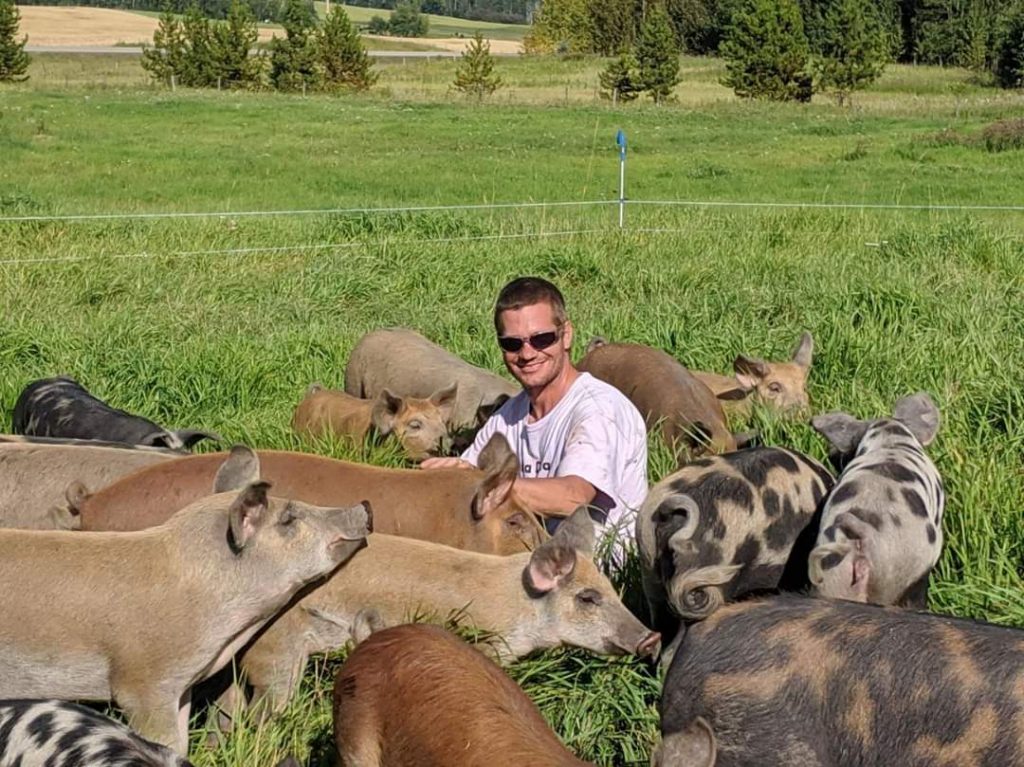
RR2CS: What are some of the climate concerns you are facing on the land?
Steve: In the Busby area, where I live, according to our municipal statistics, we’ve had seven years of drought in the last eleven years. So, it’s pretty severe. In past years of drought, the biggest concern I’ve had – it’s not about lack of grass for forage. It’s about a lack of water. Waterwells in the region are pretty poor. If you do get one, it’s only a couple gallons per minute. Instead, we rely on snowmelt to fill dugouts and ponds.
After a couple of years of drought, my dug outs were looking very empty. I was starting to wonder where I was going to get water for my animals. Suddenly, we got slammed by a heavy rainstorm. That’s pretty typical of our climate changing: severe drought followed by a heavy down pour. I remember we got five inches of rain in 36 hours! The water flooded everywhere. People were kayaking in the parking lot of the grocery store in town. I went to see my dugouts, but the water level had only raised up by a foot from the run-off – not much. However, two weeks later, the water in the dugout was overflowing out the back. Over two weeks, the rainwater had slowly infiltrated through the ground, soaked into the soil, and filled the dugouts from the ground up. It was a sign of a healthy water cycle. It was very rewarding to see that.
RR2CS: You write that it’s important to “reintegrate livestock back onto the land”. Why is that so?
Steve: On all of the eroded grain land, we need livestock back out there, recycling nutrients back into the soil. That’s how nature had it planned. In any environment where there’s a dormant season, nature put a ruminant animal. A ruminant is a cow, a deer, a sheep, an elk, a goat, or an elephant. Ruminants have four stomachs and they basically decompose plant material with microorganisms and bacteria in the gut. If you have a dormant season in an environment, for example, winter in North America, the bugs die off and there’s nothing there to decompose the plant material that’s left over. Nature brings in a ruminant animal where the bugs have a place to work – except here, they’re working inside the stomach of the cow. In a rainforest environment, there’s no need for a ruminant because the material falls to the ground, decomposers can work in the soil all year round. But here, where we have a dormant season, we need ruminants. All of the grain land out there needs to have animals again, breaking down the straw, recycling nutrients back into the soil, and increasing the water holding capacity. Getting nature cycling again.
RR2CS: Some people are arguing that we should eat less meat for a more sustainable planet. How do you respond to that argument?
Steve: There’s more damage to our environment now by monocrop agriculture than there is by livestock. It just so happens that a lot of that monocrop feed goes to livestock in feedlots, and that’s where farmers get blamed. I disagree with the feedlot industry. I think the feedlot industry is actually just a side arm of the grain industry. I don’t think it has anything to do with livestock. To me, it’s a place where they can sell the grain. The grain industry is the damaging one: the chemicals, the fertilizers, the erosion, the damaged water cycle. To me, it’s just a disaster. It kills natural habitats. The amount of erosion of topsoil that we export every year in our rivers and out to the ocean is incredible. The feedlot is just a part of that. It’s a way to sell grain. The cattle should be out on that land, grazing the forage, as it comes up. Instead of harvesting that crop, hauling it into them, feeding them in a pen, then hauling the manure back out. It’s a ludicrous concept. I don’t know how we ever came up with it. So, for those that criticize modern agriculture and the feedlot model – I agree with them. In Regenerative Agriculture, we don’t do feedlots. We don’t do monoculture grain production. We also use very little if any fertilizers or chemicals.
RR2CS: Through custom grazing, you’ve had the opportunity to observe many different herds over the years. You write that farmers should be selecting for “high production, low maintenance.”
Steve: I really value the work of Gearld Fry. He was an animal geneticist out of Arkansas. He wrote a book called Reproduction and Animal Health: How to Select, Breed, and Manage a Herd for Health and Performance on Grass. Sadly, he passed away last year. Gearld was a wealth of knowledge. I learnt a lot from him. He goes through a scenario called linear measuring. In linear measuring, you measure the proportion of the cow, from their hip height to heart girth to top line. A physically perfect animal will have low maintenance and high production. Those are the only two traits you should be selecting for. If you select for those, all of the other bad traits disappear. If, for example, a cow has bad feet, well, they’re not going to be high fertility and low maintenance because they’re not going to get to the food as well. Everything else cleans up itself. Then you’ve got this healthy, high production, low maintenance herd.
RR2CS: How do other farmers respond to the way you’re farming? Do you think there’s a shift towards regenerative farming practices?
Steve: Farming in Alberta is very traditional. It can be hard to change mindsets. But it’s slowly catching on. Over the last five years, or so, regenerative agriculture has taken a big jump. At our soils conference in Edmonton this year we had 500 or so people register. The conference sold out before the early bird deadline. That’s telling me there’s a growing demand for this knowledge.
But there’s a balance between the environmental side of what I’m doing and the economic side. We have to be able to do both. As I’ve said for years, I can clean the air and water and do these wonderful things – but I can go broke doing it. There’s a big economic component to what I teach, as well. That’s what I think a lot of younger farmers need to keen up on. We have to be able to make a living doing this, or else, it won’t last. We’ve got to have the economic component, as well.
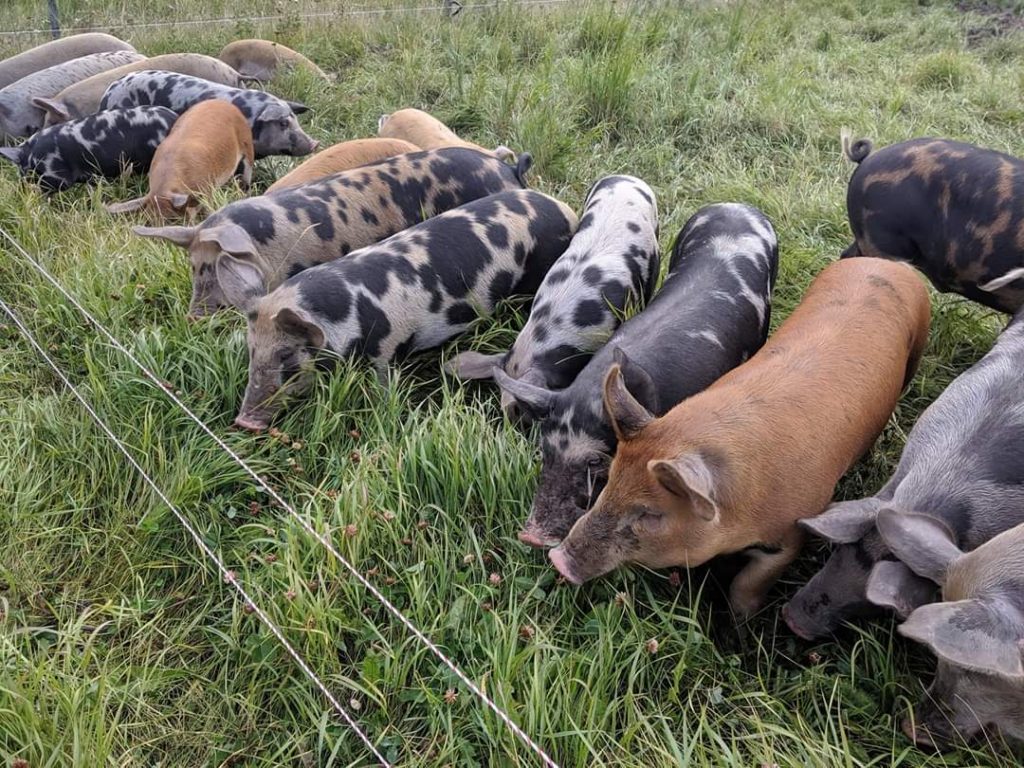
RR2CS: Some say there’s a shift happening in markets. A growing demand for grass-fed and finished beef and pasture-raised pork.
Steve: This is a good thing. The demand is growing. It’s a bit of a fight against the modern agriculture model – the feedlots, the grain industry. I remember years ago when I first started into agriculture. Everyone was criticizing grass-fed beef, saying, ‘oh it’s that yellow fat, and it’s tough, it tastes bad. It comes from Australia and Brazil.’ As a young guy, just starting up, that was the attitude that got thrown on me. People said, ‘We don’t want that stuff. We love the white fat on the grain finished. It’s got more flavour in it.’
Then I started learning about the health benefits of grass-fed and finished meat. And, also how grain actually causes a detriment to health aspect of the grain finished meat. That didn’t feel right. I wondered, okay, how do I get around the beef having yellow fat and not being tasty? Well, we started raising herds and produced beautiful, tender meat with white fat. I don’t know where that ‘yellow fat’ idea came from. It’s this mindset that we have. Honestly, I have had AAA beef with my grass finished herds. It tastes great. My wife always complains that I shouldn’t order steak in a restaurant anymore because I always complain about it. We’re used to our steak – it’s better.
RR2CS: What makes you hopeful about the future of farming?
Steve: I think that we’ve got a new generation of farmers coming back to the land. They’re not necessarily young, but they’re done with their corporate jobs and they want to get back to nature. For many, it’s been a dream to farm. They’re hopeful. They don’t have this mindset that ‘this is the way we’ve got to it because it’s the way it’s always been done.’ They’re open to the ideas of regenerative agriculture. I think that’s where we’re going to make the most ground. With some of the older farmers, they’ve made their money on real estate and crop insurance, and they want to retire the way they’ve done it. With the new farmers coming in, there’s lots of potential for regenerative agriculture to become more mainstream.
RR2CS: What advice would you share with new farmers and the next generation of farmers?
Steve: Number one, leave residue. Everything starts with water. Water is your most nutrient – you can’t do anything without it. Leave the residue that can hold onto the water. Number two, build biology. We need to create environments for not only soil biology but beneficial insects, other critters within the whole system on your farm. Every production practice that you do, think about your “employees”. I’ve got millions of employees that work above and below the soil. Ask yourself: how is this production practice going to affect my underground soil employees? My beneficial insects? Bees, grasshoppers, dragonflies, red velvet mites, predacious ground beetles – all of these critters work for me. How do I create a working environment that’s suitable to them? As a farmer, you’ve got to create good working conditions to keep your employees happy.
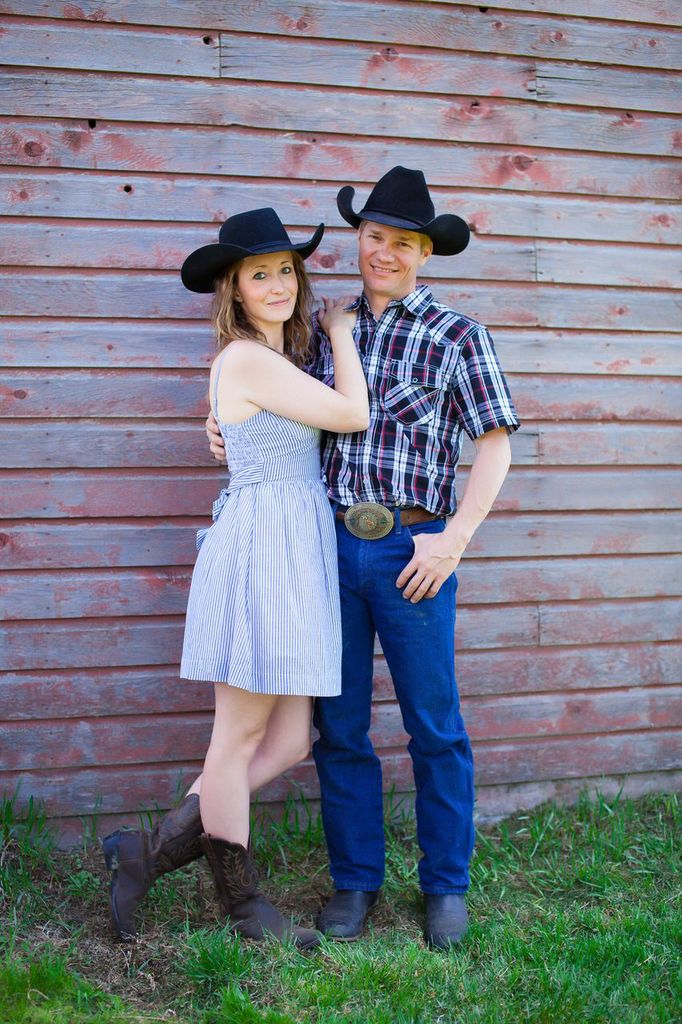
Steve Kenyon
Steve Kenyon owns and runs Greener Pastures Ranching with his wife, Amber, in Busby, Alberta. They farm regeneratively with an ethic for improving soil biology and rehabilitating eroded farmland. He speaks passionately about regenerative farming at conferences across Canada and writes regularly for The Canadian Cattleman and The Stockman Grass Farmer. Steve is the author of The Calendar of the Year-Round Grazier.

